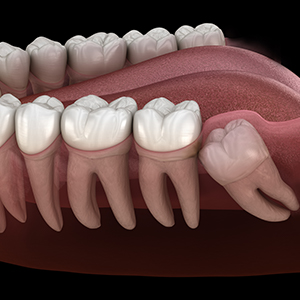Origins of Wisdom Teeth

Wisdom teeth are your third set of molars, and anthropologists believe that they were useful back when a diet of rough food like leaves, roots, nuts, and meats resulted in premature wear on the teeth. Wisdom teeth would grow in later in life, when the other teeth were needing replacement. Our modern diets are much more gentle to the teeth, and we no longer need these replacements, which is why wisdom teeth are classified as vestigial organs. Wisdom teeth start forming around the age of 10 and don’t usually erupt until around 17-25. This is an age where people are said to become wiser, so they were nicknamed “wisdom teeth”. Some people don’t ever form wisdom teeth, but for those who do they usually have between one and four. The human jaw has become smaller over time, and these extra teeth usually have a hard time coming in.
When Wisdom Teeth Erupt
When these teeth are ready to erupt, they often are blocked by the other teeth already in the mouth and can become impacted. An impacted tooth is one that gets stuck in the bone or gum tissue and this can create pockets that can attract bacteria. If this is the case, you will need them to be surgically removed, although wisdom teeth can also come in without any pain or problems and with plenty of room in the mouth. If you do have an impacted tooth, it is much more likely to become infected, and then you will definitely know you have a problem! Redness, pain, and swelling that leaves you looking like a chipmunk can result, and need to be treated immediately with antibiotics. Your wisdom teeth may come in all at one time, or you may only have one tooth erupt. You may have one impacted tooth while the rest have enough space to comfortably fit. The only way to monitor the progress of wisdom teeth is to have regular dental checkups and x-rays.
Wisdom Teeth Extraction
If you have an impacted wisdom tooth, or you are experiencing pain, damage to neighboring teeth, or infection, you will need to have them removed. Your dentist will examine your teeth and take x-rays and determine what the best options are for you. You can have wisdom teeth removed just with a local anesthesia, or you could have conscious sedation where you are in a sleepy state and pain signals are blocked. Your dentist or oral surgeon will make an incision into the gum to get the tooth, remove the tooth (possibly in sections), clean the surgical site, and stitch the wound closed (if necessary). You will have gauze placed over the site to encourage a blood clot to form. This procedure is usually relatively quick, and depending on the type of anesthesia you had you will be given time to recover. You should plan on resting after your surgery, but you can resume work and normal activities the next day as long as you are careful to avoid vigorous activity that could dislodge the forming blood clot. You will need to drink a lot of water after your surgery, but avoid using a straw as this could also disrupt the blood clot. You will need to eat soft foods for the first day, and manage your pain with over the counter pain relievers and ice. Your mouth will heal over the first week, and you may experience some swelling or bruising that will fade with time. If you had stitches they will either dissolve, or you will need to make another appointment to get them taken out. Things to watch out for after wisdom teeth extraction include: swelling that worsens after a few days, fever, severe pain, a bad taste in your mouth, or any signs of infection around the socket. Many people do not experience any complications, so don’t let a story you heard about a neighbor’s friend scare you!
Not Getting Wisdom Teeth Removed
What happens if you don’t get wisdom teeth removed that don’t have enough space to come in? You may just want to see what happens, and take your chances with them coming in, but if you have been recommended to have an extraction you should listen to your dentist! Sometimes your teeth can be impacted but you have no symptoms. These impacted teeth are more prone to decay, and can create pockets in the gums that are likely to get infected. If a wisdom tooth is partially erupted and very close to another tooth, it can make it difficult to clean that tooth and end up causing decay to adjacent teeth. There also seems to be an increased risk of gum disease in patients who keep their wisdom teeth, and gum disease can affect your gums, teeth, jawbone, and overall health. If your wisdom teeth come in but don’t have enough room, they may push on your other teeth and cause misalignment and damage. They can put pressure on your other teeth and lead to excessive wear. If you have had braces in the past, your new wisdom teeth can undo those years of straightening out your teeth! Teeth that are cramped and crooked in the mouth can be hard to clean, and can cause you to have problems biting and chewing. Even more serious, an impacted wisdom tooth could lead to jaw damage. The forming tooth is inside of a sac in the jawbone, and if the tooth is impacted that sac can fill with fluid and lead to a cyst. An infected cyst can damage teeth and weaken the jaw, and can even become a non-cancerous tumor that will need to be removed.
If you are having pain or problems related to wisdom teeth, or if you haven’t been to the dentist in awhile, give Meadowbrook Dental Care a call! Our dentists in Mineola would love to discuss your treatment options, and keep your teeth, gums, and jaw healthy!
